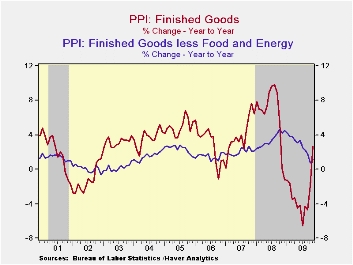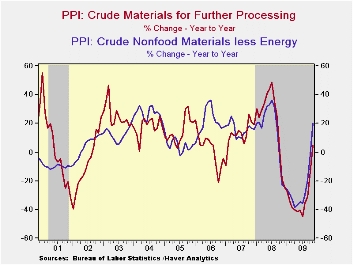 Global| Dec 15 2009
Global| Dec 15 2009U.S. PPI Jumps As Fuel Costs Surge; Core Prices Remain Strong
by:Tom Moeller
|in:Economy in Brief
Summary
There was a broadening of inflationary pressure last month as measured by the producer price index. The PPI for finished goods jumped 1.8% after the tame 0.3% October increase. The rise was by far the largest increase in months and it [...]
 There
was a
broadening of inflationary pressure last month as measured by the
producer price index. The PPI for finished goods jumped 1.8% after the
tame 0.3% October increase. The rise was by far the largest increase in
months and it lifted the y/y gain to 2.7%, its fastest since October of
last year. In addition, the November increase was more-than-double the
Consensus expectation.
There
was a
broadening of inflationary pressure last month as measured by the
producer price index. The PPI for finished goods jumped 1.8% after the
tame 0.3% October increase. The rise was by far the largest increase in
months and it lifted the y/y gain to 2.7%, its fastest since October of
last year. In addition, the November increase was more-than-double the
Consensus expectation.
Higher energy costs led the strength in the PPI last month. The 6.9% increase lifted the y/y increase to 10.6%, its strongest since September 2008. Gasoline prices increased 8.2% (35.9% y/y). Elsewhere, the gain in energy prices was more moderate. Fuel oil prices increased 10.8% but they remained down 7.1% from last year. Natural gas prices also increased a lesser 3.9% and they were down 15.6% from the year ago level. Food prices increased a moderate 0.5% but the increase left prices 1.6% lower than last year. Beef & veal prices were off 8.4% y/y, dairy product prices fell 7.3% and vegetable prices slumped 3.2% y/y.
 Excluding
food
& energy prices rose 0.5% and reversed the October decline. The
m/m increase in the core PPI contrasted with expectations for a modest
0.2% increase. The PPI for finished consumer goods less food &
energy rose 0.5% (1.2% y/y) and also reversed the October
decline. Finished durables prices increased 0.6% (0.8% y/y)
while core finished consumer nondurable goods prices rose a modest 0.4%
(2.3% y/y). Capital equipment prices increased for the first time in
three months. The 0.4% increase nevertheless left prices up just 0.4%
y/y, nearly the weakest increase since 2003.
Excluding
food
& energy prices rose 0.5% and reversed the October decline. The
m/m increase in the core PPI contrasted with expectations for a modest
0.2% increase. The PPI for finished consumer goods less food &
energy rose 0.5% (1.2% y/y) and also reversed the October
decline. Finished durables prices increased 0.6% (0.8% y/y)
while core finished consumer nondurable goods prices rose a modest 0.4%
(2.3% y/y). Capital equipment prices increased for the first time in
three months. The 0.4% increase nevertheless left prices up just 0.4%
y/y, nearly the weakest increase since 2003.
 Prices for intermediate
goods jumped 1.4%, reflecting the strength in energy prices. Core
prices also firmed and the 0.3% increase reversed the October decline.
The y/y gain in prices amounted to 0.3% which was a reversal from the
2.4% price deflation at the end of last year. Chemical, lumber and
metals prices have firmed. The crude materials PPI again reflected the
strength in energy prices and rose 5.7%. Core prices gave back the
October gain but y/y were up 20.4% due to the improved economy.
Prices for intermediate
goods jumped 1.4%, reflecting the strength in energy prices. Core
prices also firmed and the 0.3% increase reversed the October decline.
The y/y gain in prices amounted to 0.3% which was a reversal from the
2.4% price deflation at the end of last year. Chemical, lumber and
metals prices have firmed. The crude materials PPI again reflected the
strength in energy prices and rose 5.7%. Core prices gave back the
October gain but y/y were up 20.4% due to the improved economy.
The producer price data is available in Haver's USECON database. More detailed data is in the PPI and in the PPIR databases.· Bank Relationships and the Depth of the Current Economic Crisis from the Federal Reserve Bank of San Francisco can be found here.
| Producer Price Index(%) | November | October | September | Y/Y | 2008 | 2007 | 2006 |
|---|---|---|---|---|---|---|---|
| Finished Goods | 1.8 | 0.3 | -0.6 | 2.7 | 6.4 | 3.9 | 2.9 |
| Core | 0.5 | -0.6 | -0.1 | 1.2 | 3.4 | 2.0 | 1.5 |
| Intermediate Goods | 1.4 | 0.3 | 0.2 | -1.5 | 10.5 | 4.0 | 6.4 |
| Core | 0.3 | -0.2 | 0.9 | -3.0 | 7.4 | 2.8 | 6.0 |
| Crude Goods | 5.7 | 5.4 | -2.1 | 4.8 | 21.4 | 11.9 | 1.4 |
| Core | -0.8 | 0.5 | 3.6 | 20.4 | 14.8 | 15.6 | 20.8 |
Tom Moeller
AuthorMore in Author Profile »Prior to joining Haver Analytics in 2000, Mr. Moeller worked as the Economist at Chancellor Capital Management from 1985 to 1999. There, he developed comprehensive economic forecasts and interpreted economic data for equity and fixed income portfolio managers. Also at Chancellor, Mr. Moeller worked as an equity analyst and was responsible for researching and rating companies in the economically sensitive automobile and housing industries for investment in Chancellor’s equity portfolio. Prior to joining Chancellor, Mr. Moeller was an Economist at Citibank from 1979 to 1984. He also analyzed pricing behavior in the metals industry for the Council on Wage and Price Stability in Washington, D.C. In 1999, Mr. Moeller received the award for most accurate forecast from the Forecasters' Club of New York. From 1990 to 1992 he was President of the New York Association for Business Economists. Mr. Moeller earned an M.B.A. in Finance from Fordham University, where he graduated in 1987. He holds a Bachelor of Arts in Economics from George Washington University.






